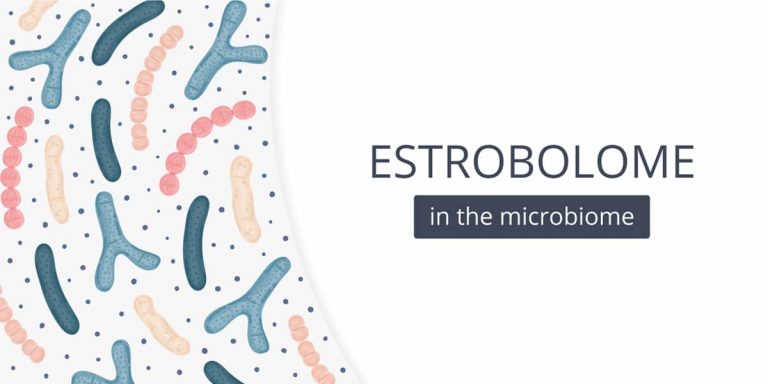Why You Need to Know About the Estrobolome
“Microbiome” has been quite the buzzword over the last few years. It’s basically the collection of microorganisms within your body, which can impact many aspects of your health. These include mood, metabolization, immunity and more.
Recent research has emerged identifying specific microbes in the digestive tract that are responsible for hormone regulation—specifically estrogen. This is known as the estrobolome, which influences estrogen metabolization. Furthermore, it can result in a hormonal imbalance, leading to estrogen-influenced conditions such as endometriosis, fibroids, menorrhagia, and even PCOS.
Estrogen is one of the most important hormones produced by the ovaries. It’s responsible for female sexual characteristics, and is built from the developing follicle in the beginning part of your cycle. This hormone helps to build the lining of the uterus to prepare for ovulation and a possible pregnancy each month.

There are 3 phases of estrogen detoxification.
PHASE 1: In the first phase, estrogen goes through the liver. There, it’s turned into metabolites known as 2-OH estrone, 4-OH estrone and 16-OH estrone.
PHASE 2: The second phase of estrogen detoxification is known as methylation. Magnesium and S-adenosylmethionine (SAM) will help the enzyme Catechol-O-Methyltransferase (COMT) to turn 2-OH and 4-OH into 2Methoxy estrone and 4Methoxy estrone. This makes the metabolites water soluble so they can be easily excreted.
PHASE 3: The 3rd phase of estrogen detoxification relies on your estrobolome. Dr. Carrie Jones, Naturopathic Doctor explains this this part really well. She describes it as: “…once estrogen is in the digestive tract, it gets packaged so that it can be excreted out through the bowel. Excess production of an enzyme called beta-glucuronidase will open up this package, and the estrogen that’s released will get reabsorbed into the body, resulting in higher circulating estrogen levels”.

Gut Hormone Connection
The gut microbiome refers to the diversity of microorganisms present. Certain microbes present in the estrobolome produce beta-glucuronidase. Microbes known to produce beta-glucuronidase include Escherichia coli, Bacteroides species, and Clostridium perfringens [3].
For healthy estrogen metabolization you need to have the right amount of beta-glucuronidase. Too much beta-glucuronidase present in the gut can result in higher estrogen levels. On the other hand, small amounts of beta-glucuronidase can result in estrogen deficiency.
PCOS and Estrobolome
Polycystic Ovarian Syndrome (PCOS) can be affected by an altered gut estrobolome. In fact, PCOS women often have hormone imbalance. Often, this imbalance is due to high androgen levels (aka testosterone) and relatively insufficient estrogen. Dysbiosis is an imbalance between microbes in the gut and is often common in women with PCOS [2].
Researchers speculate that the altered gut microbiome in PCOS women may result in lowered estrogen circulation and ultimately higher testosterone. This may be supported by research showing that PCOS rats that were exposed to fecal microbiota transplantation (FMT) resulted in decreased androgen levels and increased estrogen levels. The results were not as promising for supplementing with Lactobacillus, however, both FMT and Lactobacillus supplementation was better than the control group. Therefore, supporting gut health can be important for supporting the body’s hormone levels. [1]
How to Improve your Estrobolome
1. Feed your gut with healthy bacteria.

Probiotics are healthy strains of bacteria that can help to reduce dysbiosis. Common strains that can be supportive include Lactobacillus [1] and Bifidobacterium lactis [4]. Eating a wide variety of colorful vegetables can also improve your microbiome.
2. Consider Prebiotics
Prebiotics are abundant in fructo-oligosaccharides or inulin which feed the production of healthy probiotics. Common prebiotic foods include onions, garlic, leeks, asparagus and flax seeds.
3. Consume Fermented Foods
References
- Guo, Y., Qi, Y., Yang, X., Zhao, L., Wen, S., Liu, Y., & Tang, L. (2016). Association between Polycystic Ovary Syndrome and Gut Microbiota. PLOS ONE, 11(4), e0153196. https://doi.org/10.1371/journal.pone.0153196
- Zhang, J., Sun, Z., Jiang, S., Bai, X., Ma, C., Peng, Q., … Zhang, H. (2019). Probiotic Bifidobacterium lactis V9 Regulates the Secretion of Sex Hormones in Polycystic Ovary Syndrome Patients through the Gut-Brain Axis. MSystems, 4(2). https://doi.org/10.1128/mSystems.00017-19
- Lindheim, L., Bashir, M., Münzker, J., Trummer, C., Zachhuber, V., Leber, B., … Obermayer-Pietsch, B. (2017). Alterations in Gut Microbiome Composition and Barrier Function Are Associated with Reproductive and Metabolic Defects in Women with Polycystic Ovary Syndrome (PCOS): A Pilot Study. PLOS ONE, 12(1), e0168390. https://doi.org/10.1371/journal.pone.0168390
- Skar, V., Skar, A. G., & Strømme, J. H. (1988). Beta-Glucuronidase Activity Related to Bacterial Growth in Common Bile Duct Bile in Gallstone Patients. Scandinavian Journal of Gastroenterology, 23(1), 83–90. https://doi.org/10.3109/00365528809093853




